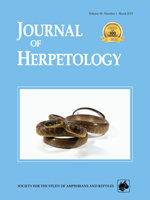Stream microhabitats are strongly influenced by adjacent terrestrial land use and other anthropogenic disturbances. Therefore, sensitive stream fauna can be highly imperiled. We investigated relative susceptibility of stream-associated salamanders to riparian land use by studying species-specific responses that influence community assembly. The Piedmont and Blue Ridge ecoregions of the southeastern United States have high aquatic biodiversity, centuries of land use, and increasingly extensive urbanization. We surveyed low-order streams in these regions for salamanders across four riparian land uses (forests, agricultural, residential, and urban) and assessed 15 habitat variables at each sampling site. We found that forested streams were more diverse compared to streams affected by riparian land uses. Our study showed two distinct assemblages of salamanders in response to riparian land use: forest-dependent, large-bodied, long-lived species sensitive to riparian land uses (disturbance avoiders) and cosmopolitan, small-bodied, short-lived species that are relatively resistant to impacts of riparian land uses (disturbance tolerants). These assemblages varied in composition between the ecoregions, with Blue Ridge harboring more land-use–intolerant species. Results indicated that multiple habitat features of the riparian zone (canopy cover, canopy height, leaf litter cover), and stream geomorphology (bank complexity, streambed heterogeneity, sedimentation) are dramatically altered by riparian land uses, and influence the assemblage structure of salamanders. Riparian buffers in both ecoregions are largely unprotected (70% in Blue Ridge, 96% in Piedmont) and are possibly threatened with anthropocentric land uses. Results suggested that conservation of stream salamander communities should be strengthened with protection and restoration of riparian forests, connectivity among riparian forests, and soil-conservation practices.
How to translate text using browser tools
1 March 2015
Importance of Riparian Forest Buffers in Conservation of Stream Biodiversity: Responses to Land Uses by Stream-Associated Salamanders across Two Southeastern Temperate Ecoregions
Thilina D. Surasinghe,
Robert F. Baldwin
ACCESS THE FULL ARTICLE

Journal of Herpetology
Vol. 49 • No. 1
March 2015
Vol. 49 • No. 1
March 2015




